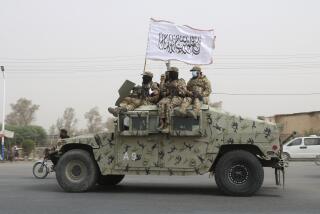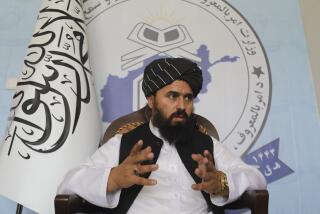Strategic Afghan village knows poverty, misery
GULBAHAR, Afghanistan — In this bustling village near the front lines of the war between the Northern Alliance and the Taliban, smugglers supply everything from cigarettes to shoelaces, a druggist moonlights as a member of the secret police and the ultimate source of authority is a man with a private army and the power of a feudal lord.
About half of the adult men of Gulbahar are unemployed. Children as young as 6 years old work long days in the bazaar, performing tasks that range from selling socks to hauling gasoline in jugs. Small groups of dazed-looking refugees arrive from Kabul every day to escape the American bombing.
But what is most remarkable about the village is that its poverty and misery are merely ordinary for Afghanistan. “It is a typical village in Afghanistan,” said Commander Norhabib, Gulbahar’s chief military and civilian authority.
Gulbahar is a patchwork of mud-brick houses climbing the foothills of the Hindu Kush mountains, home to 30,000 people about 18 miles from the front line. The village is strategically important because it is at the entrance to the gorge leading to the Panjshir Valley, the gateway to the Northern Alliance’s largest mountain stronghold. And Panjshir is the symbolic heart of the Afghan resistance: It is the birthplace of many Northern Alliance commanders, including Ahmed Shah Massoud, who was assassinated last month.
‘It is a hardship’
This village has fallen to the Taliban three times -- in 1996, 1997 and 1999. The Northern Alliance returned each time, at the cost of more lives. Gulbahar now is virtually under siege, with Taliban troops dug in to the south and mountains rising on the other three sides.
Merchants here import almost all their goods from Kabul, smuggling them through the Taliban lines. Taliban soldiers, the merchants say, demand a “duty” of about $17 for every 15 pounds of drugs. Drugs to treat dehydration from diarrhea cost $2.50, two days’ pay for civil servants. Rabies is common, but no one can afford to import anti-rabies serum. Tuberculosis is spreading, but the cost of a yearlong course of drugs has risen to $150.
“It is a hardship,” said Saderoddin Delaghra, owner of Gawat Pharmacy. “They are going to sell their furniture, their trees, their homes in order to buy drugs.”
Delaghra is the person who knows what is happening in Gulbahar’s bazaar. He knows who is sick and who is healthy, and his shop is near the intersection of the two roads to Kabul. And, he confides, he is a member of the local secret police, who regularly report on activities in town.
“I sit here and I watch what happens,” he said, pointing out the window of his shop. “I see the comings and goings.”
Village authority
The person in charge of the secret police, and almost everything else, is Commander Norhabib. His compound is across a bridge over the Shutel River; the bridge is made of steel from a Soviet armored personnel carrier. He received visitors in a whitewashed, tree-shaded house on the north bank.
He wore a traditional Afghan tunic and a pakol, the flat woolen cap with a rolled brim favored by Afghanistan’s Tajiks. While Norhabib lounged on one arm, surrounded by subordinates and several sons, Gulbahar’s residents sat with straight backs, and sought his help in settling disputes. In making decisions, he said, he consulted his military counsel and relied on the local Islamic court. But he is the council head, chief judge of the court and top general of a private army he estimates at 1,300 men. “The military is the basic pillar of this government,” he said.
He is the son of a truck driver. After graduating from high school here, Norhabib studied banking at the University of Kabul. When a communist regime seized power, he joined the mujahedeen to fight the government and then, after 1979, the Soviet Union.
When the communist government fell in 1992, he joined forces with a Pashtun warlord who fought Massoud for control of Kabul. Then Norhabib switched sides and fought with Massoud. The factional fighting tore the city apart, until the Taliban drove the warlords from Kabul in 1996.
Norhabib now says he will support the Northern Alliance to the end: “I will die at the last ditch.”
After the Taliban are defeated, Afghans will choose a new president and other leaders, Norhabib said. But that choice will be made as it has been done traditionally in Afghanistan, through agreements reached between chiefs and leaders, not at the ballot box. “I won’t accept a democracy,” he said.
Former followers
Gulbahar’s madrasah, or seminary, has 320 students. Their words echo through the courtyard of a mosque as they read aloud from the Quran. Their teacher is Mullah Ubiadullah. He had welcomed the Taliban in 1996 because he believed they would instill Islamic values.
“When they came here, we thought that the Taliban were Muslims, and that they would improve the Islamic ways of the country,” Ubiadullah said, sitting among his students in a basement room. “We were among the followers of the Taliban. But then we saw that they did not want to follow the way of Islam.”
The Taliban, he said, forced people in Gulbahar to give them guns, or to contribute money to buy them. They arrested real and suspected opponents, and whipped them with metal cables. “The Taliban made no distinction between soldiers and those who were not soldiers,” Ubiadullah said. “Every person they caught, they took to prison and punished with the cable.”
Gulbahar’s bazaar begins outside the mosque and stretches along the road leading south to Kabul. A nearly unbroken line of wooden and concrete stalls, each no larger than a closet, houses shoemakers, tailors, money-changers -- purveyors of every kind of merchandise. Carcasses of freshly slaughtered lambs hang from butcher shops and goat heads sit on the road, a feast for flies.
Veteran of wars
Basheer Ahmad sells cigarettes, walnuts, tea, toothpaste and batteries. He is a 44-year-old veteran of the many wars. His shop is far from the center of the bazaar, and prices now are high because the Taliban are near.
Ahmad lives in a two-story mud-brick compound that has windows on the upper floor. A metal gate opens into a courtyard filled with flowers and singing birds. His house lacks electricity and telephones. His wooden plough is propped against a wall: Ahmad grows wheat and tomatoes for his family’s table.
Five households, all of them cousins, live in the compound. Ahmad’s family, including six children ages 2 to 14, occupies a four-room unit with a winding staircase and windows facing the courtyard. Visitors enter only after Ahmad’s wife, for modesty’s sake, moves to another unit. In the main room upstairs, Ahmad’s 7-year-old son Namat lies on a folded blanket in the corner. “He has had the typhoid fever for the past 10 days,” Ahmad said.
Ahmad did not mind being a soldier. But he does not romanticize the work, nor exaggerate his exploits. Yes, he shot at the Taliban; as far as he knows, he never killed anyone. Most of his friends, he calculated, have died in the past 22 years of fighting. And he misses them.
Over tea, Ahmad recalled the death of a neighbor, 21-year-old Saifuddin. “His crime was that he had his marriage photo hung on the wall in his house,” Ahmad said. The Taliban believe that images of living things are profane. When a group of Taliban saw the photo, they dragged Saifuddin out of his house and whipped him to death. Ahmad wants a normal life, a normal government -- what he called “good order.”
“We want a national government in Afghanistan, a public government,” he said. But he was unsure peace would come. The talk turned to his local school. The Soviet Union destroyed it. Ahmad was among the first to volunteer to rebuild it.
It is a shame, he said, that so many children didn’t attend school. He intends to send his three sons and three daughters through all 12 grades. They may not have better lives than their parents, but they will be educated, he said. “In this situation, I can’t have any other hopes for them.”
More to Read
Sign up for Essential California
The most important California stories and recommendations in your inbox every morning.
You may occasionally receive promotional content from the Los Angeles Times.










